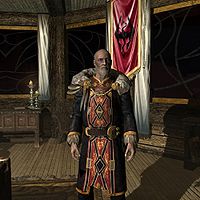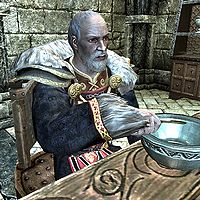Lore:Titus Mede II
| Emperor Titus Mede II | |||
|---|---|---|---|
 Emperor Titus Mede II
Emperor Titus Mede II |
|||
| Race | Imperial | Gender | Male |
| Born | 4th Era |
||
| Died | 4E 201 Solitude Inlet |
||
| Resided in | Imperial City | ||
| Reign | 4E 168- 4E 201 |
||
| Appears in | Skyrim, Legends | ||
Titus Mede II was an emperor of the Mede Dynasty during the Fourth Era. Three years after his accession, Titus II was pulled into the Great War against the Aldmeri Dominion. After four years, Titus II and the Imperial Legion defeated the Aldmeri Dominion's main army in Cyrodiil, but the Empire was in no shape to continue the war, forcing Titus II to sign the controversial White-Gold Concordat.[1] The Concordat outlawed the worship of Talos and forced the Empire to cede a large section of southern Hammerfell to the Dominion.[1] The ban on Talos worship caused discontent and eventually led to the Stormcloak Rebellion in Skyrim.
Contents
Biography[edit]
Background[edit]
Little is known of Titus Mede's life prior to his accession to the throne. It is known that he had an aunt named Alexia Vici and a first cousin named Vittoria Vici.[2][3]
When Titus Mede II acceded to the Ruby Throne in 4E 168, he inherited a weakened Empire.[1] Black Marsh had been lost to Imperial rule since the aftermath of the Oblivion Crisis.[1][4]:206[5]:43 Morrowind was devastated by the Red Year and the Accession War.[6][1][7] Morrowind ceased to be an Imperial province at some point prior to 4E 48.[6][4]:109[5]:16 In 4E 22, the Thalmor seized control of the Summerset Isles, seceding from the Empire and renaming the province to Alinor.[1][8] In 4E 29, the Altmer and their Bosmer collaborators staged a coup, overthrowing the Imperial government in Valenwood and proclaiming the formation of the Third Aldmeri Dominion.[1][8][4]:154 Elsweyr ceased to be an Imperial province at some point prior to 4E 48.[4]:180 By 4E 115, Imperial influence in Elsweyr was so diminished that the Empire was unable to respond to the coup that dissolved the Elsweyr Confederacy and recreated the kingdoms of Anequina and Pellitine as client states of the Aldmeri Dominion.[1] Hammerfell was plagued by infighting between the Crowns and Forebears.[1] This left Cyrodiil, High Rock, and Skyrim as the only provinces under imperial rule that remained prosperous and peaceful by the time of Titus II's accession.[1]
The Great War[edit]
Titus Mede II had only a few years to consolidate his rule before his leadership was put to the test. On the 30th of Frostfall, 4E 171, the Aldmeri Dominion sent an ambassador to the Imperial City, demanding tribute, the disbandment of the Blades, the outlaw of Talos worship, and the cession of large sections of Hammerfell to the Dominion.[9][10] The Emperor's generals warned of the Empire's military weakness, but despite this, he rejected the Dominion's ultimatum, thus beginning the Great War.[1]
Within days, armies of the Aldmeri Dominion invaded Hammerfell and Cyrodiil simultaneously.[1] A force commanded by the Thalmor general, Lord Naarifin, attacked Cyrodiil from the south, and Leyawiin soon fell to the invaders, while Bravil was besieged. Lady Arannelya led another army that entered western Cyrodiil from Valenwood, bypassed Anvil and Kvatch, and crossed to Hammerfell to join the Dominion forces landing on its southern coast. During 4E 172, the Dominion advanced deeper into Cyrodiil, capturing Anvil, Bravil, and Skingrad. By the end of 4E 172, Naarifin had advanced to the walls of the Imperial City. In 4E 173, fresh legions from Skyrim bolstered the Emperor's main army in the Imperial City, but the Dominion crossed the Niben and began advancing up the eastern bank. By the end of 4E 173, the Imperial City was surrounded on three sides, and only the northern supply route to Bruma remained open. On the 12th of Second Seed, 4E 174, the Dominion launched a massive assault on the Imperial City. One Aldmeri army went north to completely surround the city, while Naarifin's main force attacked the city walls from the south, east, and west. With the city surrounded, Titus II made the decision to break out of the city rather than make a last stand. While the Eighth Legion fought a desperate and doomed rearguard action on the city walls, Titus II broke out of the city to the north with his main army, breaking through the surrounding Dominion forces and linking up with reinforcements marching south from Skyrim under General Jonna.[11] Following the Emperor's breakout, the Dominion forces captured the Imperial City, and they then sacked it.[1][11][12][13]
After the breakout from the Imperial City, Titus II and the Imperial Army retreated north to Skyrim.[11] During the winter of 4E 174-175, the Dominion seems to have believed that the war in Cyrodiil was all but over, and they made several attempts to negotiate with Titus II. The Emperor misled the Dominion into believing that he was considering surrendering; all the while, he was gathering his forces to retake the Imperial City.[1]
Titus II divided his forces into three armies. One army, with legions from Hammerfell under General Decianus, was concealed in the Colovian Highlands near Chorrol. The second army, comprised mostly of Nord legions under General Jonna, took up position near Cheydinhal. The Emperor commanded the main army, which was positioned to the north of the Imperial City, where it would launch the main assault. On the 30th of Rain's Hand, 4E 175, the Battle of the Red Ring began. General Decianus' army swept down upon the city from the west, while General Jonna's legionaries went south along the Red Ring Road.[11] By the fifth day of the battle, the Imperial City was surrounded. Titus II led the main assault from the north, capturing Lord Naarifin while supposedly wielding Goldbrand.[14] The Dominion forces attempted to break out of the city to the south, but they failed, and, ultimately, the main Dominion army in Cyrodiil was destroyed. The Imperial City was once again in imperial hands.[1][15] After the Battle of the Red Ring, Titus II personally decorated a legionary named Martius Silius.[16]
An alternate account of the events of the Battle of the Red Ring, as told by the Moth Priest Kellen, asserts that it was actually a Forgotten Hero and not Titus II who led the Imperial Army at the battle.[17] This account claims that the hero and their companions learned about Lord Naarifin's plot to sacrifice the citizens of the Imperial City to summon masses of Daedra in a prophecy known as "The Culling".[11] They told the Emperor of the prophecy, who was horrified to hear of Naarifin's plan but knew an attack on the Imperial City was doomed to fail.[18] Titus II informed the hero and their companions that the Dominion could somehow predict the Imperial Legion's every move, so they volunteered to infiltrate the city and discover the source of this ability.[18]
The hero and their companions discovered that the Orb of Vaermina was what allowed Naarifin to see the Empire's movements, and after destroying it, they fled the Imperial City to inform the Emperor.[19][20] When they returned to the Emperor's camp, they found the imperial guards dead and Titus II wounded from a failed assassination attempt by the Dominion.[21] Titus II was too wounded to lead the assault, so he told the hero to wear his armor and masquerade as him at the Battle of the Red Ring.[21] After the retaking of the Imperial City, the hero quietly disappeared, and the true Emperor took command.[22]
The White-Gold Concordat[edit]
Although victorious at the Battle of the Red Ring, the Empire was in no shape to continue the war. Titus II knew that the Empire would be in no better position to negotiate peace, and in late 4E 175, the Empire and the Aldmeri Dominion signed the White-Gold Concordat, ending the Great War. The Concordat's two most controversial terms were the ban on Talos worship and the cession of a large section of southern Hammerfell.[1][23][24][25] Critics of the treaty pointed out that the terms of the Concordat were almost identical to the ultimatum the Emperor rejected in 4E 171. The Redguards, however, refused to accept the Concordat, being unwilling to accept the loss of so much of their territory. In order to preserve the peace treaty, Titus II was forced to officially renounce Hammerfell as an imperial province.[1]
Aftermath of the War[edit]
After five more years of fighting, the Redguards fought the Dominion to a standstill in 4E 180. The two sides signed the Second Treaty of Stros M'kai, resulting in the withdrawal of the Aldmeri Dominion from Hammerfell. Some critics claimed that the Dominion's failure to defeat the Redguards was proof that the White-Gold Concordat was unnecessary, and that if Titus II had kept his nerve, the Dominion could have been defeated by the combined forces of Hammerfell and the rest of the Empire.[1]
Some viewed Titus II's decision to sign the White-Gold Concordat as cowardice,[25][26] while others viewed the Emperor's decision to sign the Concordat as the only thing that allowed the Empire to survive the Great War.[27][28][29] Local leaders, such as the jarls of Skyrim, had no say in the signing of the treaty, so the Empire gave them chests of gold as compensation.[30]
In 4E 174, the Reachmen took advantage of the Imperial Legion's preoccupation with the Great War by overthrowing Hrolfdir, Jarl of Markarth, and declaring the Reach to be an independent kingdom.[31][32][33]:501 By 4E 176, Jarl Hrolfdir was desperate to retake the Reach, so he turned to a Nord militia led by Ulfric Stormcloak and promised that he would permit the free worship of Talos in Markarth in exchange for their help retaking the hold.[31][32][33]:501 In a short and bloody war, Ulfric and the Nord militia laid siege to the gates of Markarth, and when they breached the city gates they drove the Reachman rebels from the city.[31][32][33]:501 The surviving Reachman rebels fled into the hills and continued to fight the Empire in the Forsworn Rebellion.[31][32][34]
Shortly after the retaking of Markarth, the Thalmor found out about the promise of legal Talos worship, so they sent an ambassador to the Imperial City to confront Titus II. Faced with the threat of a second war, the Emperor was forced to send the Imperial Legion to assist the Thalmor Justiciars in Markarth.[35] In order to preserve the White-Gold Concordat, Ulfric Stormcloak and much of the Nord militia were arrested in an event called the Markarth Incident. Some regard the Markarth Incident as the beginning of the Stormcloak Rebellion.[32][33]:501[35] Following the Markarth Incident, Titus II had no choice but to suppress Talos worship by allowing the Thalmor Justiciars to enforce the terms of the treaty.[36]
The Stormcloak Rebellion[edit]
Soon after the Markarth Incident, Ulfric founded the Stormcloaks, a group dedicated to the worship of Talos.[33]:552-553 The Stormcloaks reviled Titus II for his perceived betrayal in the Markarth Incident.[33]:420 In 4E 201, Ulfric, now Jarl of Windhelm, killed the High King of Skyrim, Torygg, in single combat with the power of the Thu'um.[29][37][38] The Empire branded Ulfric a murderer and traitor,[27][36][39] while some Nords believed the duel was legal and true to the old ways of Skyrim,[37][40][41] thus officially beginning the Stormcloak Rebellion.
The western holds of Haafingar, Hjaalmarch, the Reach, and Falkreath, remained under Imperial control.[33]:261[42] In the east, the Old Holds of Eastmarch, Winterhold, the Pale, and the Rift supported the Stormcloaks.[33]:261[42][43] Whiterun was neutral, but Jarl Balgruuf the Greater was more supportive of the Empire.[33]:532[43][44] After the rebellion broke out, a few months prior to Last Seed 4E 201, Titus II sent General Tullius to Skyrim to serve as the province's military governor.[27][39] The Empire did not launch an all-out war against the Stormcloaks, which resulted in the Imperial Legion forces in Skyrim receiving very few reinforcements, forcing them to recruit locally.[37][45] Titus II canceled his trip to Skyrim to attend the wedding of his cousin, Vittoria Vici, when he realized his presence would necessitate a more direct role in the Stormcloak Rebellion.[46] On 15 Last Seed, 4E 201, the Emperor sent a letter to General Tullius, ordering him to recover the Lord's Mail and telling him to wear the relic after its recovery.[47]
Assassination[edit]
In 4E 201, Amaund Motierre, a member of the Elder Council, performed the Black Sacrament to have the Dark Brotherhood kill multiple targets in an elaborate plan to draw out and assassinate the Emperor.[48][49][50] Motierre wanted to have the Emperor assassinated to usher in a change in Imperial policy.[49] To force Titus II to travel to Skyrim, the Brotherhood killed the first target, Vittoria Vici, at her wedding in Solitude.[46][51][50] With the Emperor soon to arrive in Skyrim, Commander Maro, the leader of the Penitus Oculatus in Skyrim, began preparing the security for the Emperor's visit.[50][52][53] The Brotherhood killed the second target, Commander Maro's son Gaius, and framed him in a plot to assassinate the Emperor, which they believed would render the Commander unable to perform his duties and weaken the Emperor's protection.[52][54] The Brotherhood killed the third target, the renowned chef known as the Gourmet, so an assassin could impersonate him and then poison Titus II's food.[50][55] At the Emperor's Tower of Castle Dour, the assassin killed an individual who was believed to be Titus II, but he was actually a body double.[56] Commander Maro used the body double to catch the assassin in the act and kill them.[57] Maro also had his agents attack the Dark Brotherhood sanctuary near Falkreath, destroying it and killing most of the assassins.[58]
The assassin who killed the Emperor's body double managed to survive, and they informed Motierre that they still intended to honor the contract. Motierre informed the assassin that Titus II was onboard his ship, the Katariah, in the Solitude Inlet, and once the assassin arrived, they made their way through the ship until they reached the Emperor's Quarters. The assassin's presence did not surprise Titus II, who told them that he believed it was the Dark Brotherhood's destiny to assassinate him.[59] He only asked that the assassin honor his last request and kill the individual who ordered his assassination.[59] Titus II then turned around, and the assassin killed him.[60] It is unknown if the assassin honored his final request.
Certain accounts assert that the destruction of the Dark Brotherhood occurred before it could assassinate Titus II.[61]
Gallery[edit]
-
The Katariah, ship of Titus II, named after Empress Katariah
Notes[edit]
- Titus II was rumored to keep a prime elixir of resist poison with him at all times.[62]
See Also[edit]
- For game-specific information, see the Skyrim real and decoy articles and Legends character and card articles for Titus Mede II.
References[edit]
- ^ a b c d e f g h i j k l m n o p q r The Great War — Legate Justianus Quintius
- ^ Alexia Vici's dialogue in Skyrim
- ^ Vittoria Vici's dialogue in Skyrim
- ^ a b c d The Infernal City — Greg Keyes
- ^ a b Lord of Souls — Greg Keyes
- ^ a b Adril Arano's dialogue in Skyrim: Dragonborn
- ^ Lymdrenn Tenvanni's Journal — Lymdrenn Tenvanni
- ^ a b Rising Threat, Vol. IV — Lathenil of Sunhold
- ^ Esbern's dialogue in Skyrim
- ^ Boregis' dialogue in Blades
- ^ a b c d e Kellen's dialogue in Legends
- ^ Enchanter's Primer — Sergius Turrianus
- ^ Madena's dialogue in Skyrim
- ^ Eranya's Journal — Eranya
- ^ Imperial Condolences — Praefect Pius Bruccius
- ^ Arielle Themond's dialogue in Blades
- ^ Events of The Forgotten Hero story in Legends
- ^ a b Events of A Fractured Legion in Legends
- ^ Events of Interlude in Legends
- ^ Events of Reive's Wrath in Legends
- ^ a b Events of A Knife in the Dark in Legends
- ^ Events of Epilogue in Legends
- ^ Skyrim's Rule — Abdul-Mujib Ababneh
- ^ Flight from the Thalmor — Hadrik Oaken-Heart
- ^ a b Heimskr's dialogue in Skyrim
- ^ Thongvor Silver-Blood's dialogue in Skyrim
- ^ a b c Hadvar's dialogue in Skyrim
- ^ Delphine's dialogue in Skyrim
- ^ a b Loading Screens in Skyrim
- ^ Conversation between Balgruuf the Greater, Proventus Avenicci, and Irileth during Message to Whiterun in Skyrim
- ^ a b c d The Bear of Markarth — Arrianus Arius, Imperial Scholar
- ^ a b c d e Igmund's dialogue in Skyrim
- ^ a b c d e f g h i The Elder Scrolls V: Skyrim: Prima Official Game Guide — David Hodgson
- ^ Kibell's dialogue in Skyrim
- ^ a b Cedran's dialogue in Skyrim
- ^ a b Alvor's dialogue in Skyrim
- ^ a b c Ulfric Stormcloak's dialogue in Skyrim
- ^ Sybille Stentor's dialogue in Skyrim
- ^ a b General Tullius' dialogue in Skyrim
- ^ Roggvir's dialogue in Skyrim
- ^ Gerdur's dialogue in Skyrim
- ^ a b The Holds of Skyrim
- ^ a b Legate Rikke's dialogue in Skyrim
- ^ Balgruuf the Greater's dialogue in Skyrim
- ^ Legate Constantius Tituleius' dialogue in Skyrim
- ^ a b Astrid's dialogue in Skyrim
- ^ Letter to General Tullius
- ^ Events of The Silence Has Been Broken in Skyrim
- ^ a b Amaund Motierre's dialogue in Skyrim
- ^ a b c d Amaund Motierre's Sealed Letter — "A friend"
- ^ Events of Bound Until Death in Skyrim
- ^ a b Gabriella's dialogue in Skyrim
- ^ Letter from Father — Commander Maro
- ^ Events of Breaching Security in Skyrim
- ^ Events of Recipe for Disaster in Skyrim
- ^ Events of To Kill an Empire in Skyrim
- ^ Commander Maro's dialogue in Skyrim
- ^ Events of Death Incarnate in Skyrim
- ^ a b Emperor Titus Mede II's dialogue in Skyrim
- ^ Events of Hail Sithis! in Skyrim
- ^ Events of Destroy the Dark Brotherhood! in Skyrim
- ^ Prime Elixir of Resist Poison description in Blades





